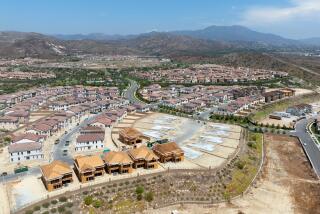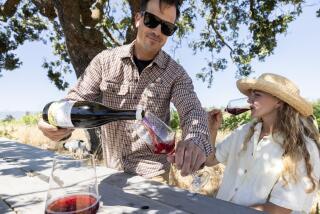Newest Threat to Orange County’s Farms: Drought : Agriculture: The Irvine Co., which owns thousands of acres, may soon have to decide which of the farmers who lease its land will get water and how much each can have.
- Share via
Out here at the edge of the orange groves, Orange County’s past collides with its future.
Crouched just a stone’s throw away--on what was once farmland too--are the gleaming new malls and condominiums and houses of Irvine and Tustin. Many of the remaining groves, redolent with the fragrance of oranges, are slated for the same fate.
The immediate threat to this farmland, though, isn’t development. A slowdown in the housing market may buy these farms a few more years.
Right now, the threat is drought.
All this land, all these thousands of acres, belongs to one concern: the Irvine Co. The land is the remnant of an even larger farm--the Irvine Ranch--that had been run by the company for almost a hundred years, when it was carved out of three sprawling Mexican and Spanish ranchos.
If the five-year-long drought persists into a sixth year, the company may have to make some of the toughest decisions it has faced in those hundred years: Which of the farmers who lease its land will get water? And how much will they get?
“To be fair to our tenants, we’ve told them we’re not sure how we’ll deal with the shortage,” said Pete Changala, director of the company’s agricultural division.
At worst, though, says the company, some of its tens of thousands of 30-year-old orange trees may have to go dry.
Farming hasn’t been the giant Irvine Co.’s main business for a quarter century or so. But at one time the Irvine family ran the sprawling ranch--nearly five times the size of Manhattan--almost like a feudal barony.
The family bought more than 100,000 acres of land cheap in the 1860s, shortly after another drought wiped out the local cattle ranching business. The ranch raised sheep, but under James Irvine Jr. it turned to farming a variety of crops.
Shortly after the turn of the century, Orange County raised more lima beans than any place else in the world. Much of it came from the Irvine Ranch, which in 1918 cultivated 60,000 acres for lima beans alone.
By the 1950s, the Irvine family realized it was sitting on a gold mine--land for development. Its property stretched 22 miles inland, from Newport Beach on the coast to the mountains separating Orange County from Riverside County. At its widest point, the ranch was nine miles. It is still, the company says, the largest urban landholding in the nation.
And the land was squarely in the path of the postwar building boom that was turning northern Orange County into a suburb of Los Angeles. With all that land, the company began to build on a vast scale: The new town of Irvine, begun in the early 1960s, is now a bustling city of 110,000.
It’s Irvine to the south, in fact, and Tustin to the west that are marching over what remains of the ranch’s farmland--about 8,400 acres.
Irvine isn’t the only place in Orange County where the open fields of farms huddle against subdivisions and office buildings as forlorn reminders of the county’s agricultural past. There’s the occasional lonely bean field in urban Costa Mesa, for instance. But nowhere does the county’s past mix so closely with its subdivided present as in Irvine.
The Irvine Co. is not the only giant landowner and developer that started out as a farm and still grows crops while waiting to fill up its thousands of acres with houses and shopping centers and offices. And it is not the only one facing trouble because of the drought.
The Santa Margarita Co., manager of another 40,000 acres owned by the O’Neill family, says some of its farmers have already left the land because of the drought. Normally 2,500 head of cattle range over its brown hills around San Juan Capistrano. There are fewer than half that number now.
Santa Margarita Co. got a later start in building than the Irvine Co. and is farther south, away from the action, so parts of it will probably remain a working ranch far longer. “We’ve been cattle ranchers for 110 years,” said a spokesman for the company, “and we will be in the business for generations to come.”
The farmers on the Irvine Co. land, though, are by far the largest remaining agricultural operation in the county. The biggest of those farmers, Bakersfield-based Sun World International, grows more Valencia oranges than anybody else in California. The ranch also produces more than 4 million pounds of avocados a year, as well as grapefruit, lemons, strawberries, bell peppers, tomatoes and beans.
Most of it is sold abroad, especially in the Pacific Rim. Americans tend to favor navel oranges over Valencias, which are mostly grown in Florida and usually used for making juice. The extra-juicy Valencias grown on the ranch, though, are prized by the residents of Hong Kong and Singapore, where the smooth-skinned fruit is sold from pushcarts.
Farming in the Los Angeles basin isn’t cheap. Water imported from Northern California costs about $600 for a million gallons. The same amount of water costs a farmer near Sacramento just a couple of bucks.
And even though the Irvine Co. says privately that the income from leasing the land barely covers its taxes, leasing farmland in an urban area such as this is expensive.
That’s why the company began conserving water even before the drought began, and when it turned over a big part of its farming operation to Sun World in the late 1980s, the tenant was interested in conservation too.
And water usage dropped. A good bit of the drop was due to the fact that about 1,000 acres of farmland were developed between mid-1987 and mid-1990. But much of the savings was due to conservation. Altogether, annual usage over this same period dropped to 22,000 acre feet from 36,500 acre feet. An acre foot is an acre of water a foot deep, or about 326,000 gallons.
A lot of that water comes from the Metropolitan Water District, the public agency that acts as a wholesaler of water in Southern California. MWD gets the water from the Colorado River and from melted snow that runs down from the Sierras and is held in a series of reservoirs in the Sacramento area.
The agency has told its retailers--the local water districts--that they will get 50% lesswater for agricultural use beginning March 1 and 20% less for business and home users. Somecities have already started water rationing.
That could spell trouble at the Irvine Ranch Water District, once the ranch’s own private water works and now a public agency that sells water not only to the ranch but to the city of Irvine as well.
So far drought has caused little disruption there. In part, that’s because the water district has bought surplus water and stored it in a reservoir called Irvine Lake.
About 45% of the water sold by the district goes to agriculture, but even if the drought got worse, residential would have little claim on it because most of that water is not potable.
The Irvine Co. also has its own wells on the ranch, but the underground water is not the best for farming. Through a quirk of geology, the well water contains a high percentage of salts, which are inimical to plants. Even if there were enough water underground to keep all the fields green--which there isn’t--it couldn’t be the only source of water for the fields except as a last resort because all that salt would hurt the crops.
The new types of irrigation the farmers are using make this problem worse. It used to be that you’d just flood the furrowed rows with water. But this was wasteful, since as much as a third of the water ran off.
Now the farmers here use hoses that drip water gently into the earth directly around the roots at the rate of about four gallons an hour per tree. But with minimum amounts of water in the confined area around the roots, the buildup of salt becomes a bigger problem. Many of the orange trees on the ranch are already surrounded by a white ring in the soil, a sign of salt.
The ranch also uses water reclaimed from sewerage treatment facilities. The water district sells this reclaimed water to irrigate public parks, greenbelts and farms. The district is one of only four among the dozens in Orange County to do so. None of this water is drinkable without additional treatment, although it’s usable for irrigation.
But if the drought persists, the city, the school district, the county and the state--all of which maintain parks and open spaces in Irvine--may start to eye a larger share of the reclaimed water that now goes to agriculture from the sewage treatment plant.
“We haven’t got to the point where we need to make a decision on that yet,” said Greg Heiertz, director of conservation at the water district.
While there seems to be enough water to get the ranch’s farmers through this year, the future is not bright.
“You can’t go on forever in a drought and expect there to be water,” said Changala. “1992 holds no promise for us.”
More to Read
Sign up for Essential California
The most important California stories and recommendations in your inbox every morning.
You may occasionally receive promotional content from the Los Angeles Times.










